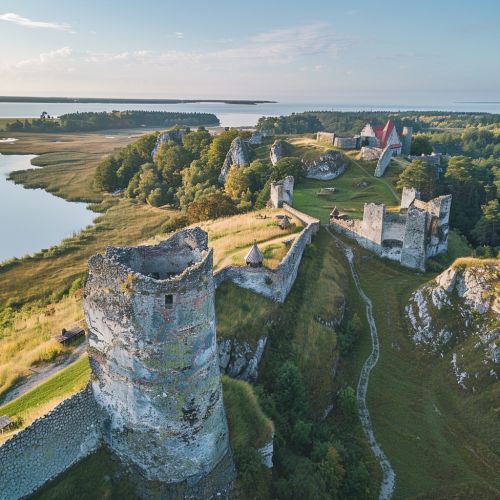History of the Baltic States
Prehistory and Early History
The history of the Baltic States, comprising Estonia, Latvia, and Lithuania, is a complex tapestry woven from the threads of various cultural, political, and social influences. The region's early history is marked by the settlement of Finno-Ugric and Baltic tribes. Archaeological evidence suggests that human habitation in the Baltic region dates back to at least 9000 BCE, with the arrival of the first hunter-gatherer communities.
Bronze and Iron Ages
During the Bronze Age (circa 1800-500 BCE), the Baltic region saw the development of distinct cultural groups, including the Narva and Corded Ware cultures. These groups engaged in trade with neighboring regions, exchanging amber, which was abundant along the Baltic coast, for metal goods. The Iron Age (circa 500 BCE-1200 CE) brought significant changes, including the introduction of iron tools and weapons, which facilitated agricultural expansion and the establishment of fortified settlements.
Medieval Period
Viking Age
The Viking Age (circa 800-1050 CE) had a profound impact on the Baltic region. The Vikings, particularly the Swedes, conducted raids and established trade routes along the eastern Baltic coast. They founded settlements and trading posts, such as Grobin in present-day Latvia, which served as important centers for commerce and cultural exchange.
Christianization and the Crusades
The Christianization of the Baltic region began in earnest in the 12th century. The Northern Crusades, led by German and Danish crusaders, aimed to convert the pagan Baltic tribes to Christianity. The Livonian Brothers of the Sword, a military order, played a crucial role in the conquest and conversion of the region. By the early 13th century, the territories of present-day Estonia and Latvia were incorporated into the Livonian Confederation, a feudal state under the control of the Teutonic Order.


Grand Duchy of Lithuania
The Grand Duchy of Lithuania emerged as a powerful state in the 13th century, uniting various Baltic and Slavic tribes under its rule. Under the leadership of Grand Duke Mindaugas, Lithuania adopted Christianity in 1251, securing its position as a significant political entity in Eastern Europe. The Grand Duchy expanded its territory through military conquests and strategic alliances, eventually forming a personal union with the Kingdom of Poland in 1386, known as the Polish-Lithuanian Commonwealth.
Early Modern Period
Polish-Lithuanian Commonwealth
The Polish-Lithuanian Commonwealth, established by the Union of Lublin in 1569, was a dual state characterized by a unique political system known as the "Golden Liberty." This system granted significant autonomy to the nobility and established a democratic governance structure. The Commonwealth played a crucial role in the cultural and intellectual development of the Baltic region, fostering the spread of the Renaissance and Reformation movements.
Swedish and Russian Dominance
The 17th and 18th centuries were marked by the struggle for dominance over the Baltic region between Sweden and Russia. The Great Northern War (1700-1721) resulted in the decline of Swedish power and the rise of the Russian Empire. By the end of the war, Estonia and Latvia were incorporated into the Russian Empire, while Lithuania remained part of the Polish-Lithuanian Commonwealth until its partitions in the late 18th century.
19th Century
Russian Rule
The 19th century saw the Baltic States under Russian rule, with Estonia and Latvia as part of the Baltic Governorates and Lithuania as part of the Vilna Governorate. The Russian Empire implemented policies aimed at Russification, including the promotion of the Russian language and culture. Despite these efforts, national consciousness and movements for independence began to emerge among the Baltic peoples.
National Awakening
The National Awakening movements of the 19th century were characterized by a resurgence of interest in Baltic languages, culture, and history. Intellectuals and activists, such as the Estonian poet Kristjan Jaak Peterson and the Latvian writer Krišjānis Barons, played pivotal roles in fostering national identity. The publication of national epics, such as the Estonian "Kalevipoeg" and the Latvian "Lāčplēsis," further solidified the cultural revival.
20th Century
Independence and Interwar Period
The aftermath of World War I and the Russian Revolution provided an opportunity for the Baltic States to declare independence. Estonia, Latvia, and Lithuania proclaimed their independence in 1918 and successfully defended their sovereignty during the subsequent wars of independence. The interwar period was marked by efforts to establish stable political systems, economic development, and cultural flourishing.
Soviet and Nazi Occupations
The Molotov-Ribbentrop Pact of 1939 between Nazi Germany and the Soviet Union led to the occupation and annexation of the Baltic States by the Soviet Union in 1940. The subsequent Nazi occupation from 1941 to 1944 brought further suffering and devastation. The return of Soviet control in 1944 resulted in the incorporation of the Baltic States into the Soviet Union as constituent republics.
Soviet Era
The Soviet era was characterized by political repression, forced collectivization, and Russification policies. Despite these challenges, the Baltic States maintained a strong sense of national identity and resistance. The Singing Revolution of the late 1980s, a series of peaceful protests and demonstrations, culminated in the restoration of independence for Estonia, Latvia, and Lithuania in 1991.
Post-Independence Period
Transition to Democracy and Market Economy
The post-independence period was marked by significant political, economic, and social transformations. The Baltic States transitioned from centrally planned economies to market economies, implemented democratic reforms, and sought integration into European and transatlantic institutions. Estonia, Latvia, and Lithuania joined the European Union and NATO in 2004, solidifying their positions as part of the Western political and economic sphere.
Contemporary Developments
In recent years, the Baltic States have continued to develop their economies, strengthen democratic institutions, and enhance regional cooperation. They have also faced challenges, including security concerns related to Russian aggression and the need to address social and economic disparities. The Baltic States remain committed to their European and transatlantic alliances, playing active roles in regional and international organizations.
